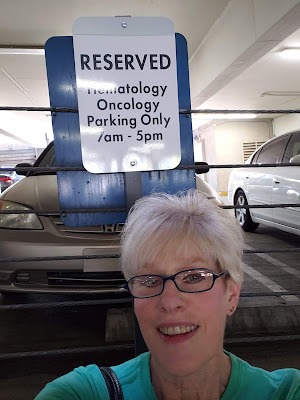October/November/December 2009...
Most of my life I was VERY presumptuous about being healthy, taking my (mostly) GOOD health for granted...
I was committed to annual check-ups for all of us, and so late October 2009, my daughter and I went for our annual and very routine physicals.
Surprise, surprise... my routine blood tests revealed extreme Anemia, significant White and Red Cell issues, low Platelets, and a variety of other CBC red flags! I was (stupidly) not worried when my GP doc left repeated phone messages to contact him, and when we did speak, I (stupidly) requested postponement of his referral appointment to the Hematology Dept until the end of the Fall academic term.
Arriving for my first appointment Dec 14, 2009, I was confronted with the check-in sign that read: "Hematology/Oncology"... What? Nooooo! not me... I must be in the WRONG place! And so my diagnosis journey began with vials and vials of blood drawn "stat", urgent Dr consultations, a surprise and painful Bone Marrow Biopsy, a full body Skeletal Scan, more blood tests stat, and then on 12.30.2009... THE revealing meeting... the "huh-what" moment ... the confirmation diagnosis that I, Julie, have CANCER!!!
Happy New Year to me, I just learned a new vocabulary word:
Multiple Myeloma!!! MM, Multiple Mye-what-loma!!!
January - June 2010
My medical metamorphosis began.
I read, and read, and read and researched and researched MM. I trusted my expert Oncology/Hematology team's plan and began my "New Normal" as a cancer patient.
My treatment plan was developed to include powerful Dexemthesone steroids paired with Revlimid chemotherapy, with the plan to be hospitalized for an Autologous Stem Cell Transplant July 2010.
I began living "one day at a time" like never before.
Jim was a wreck. Alissa and Scott were stunned; family and friends shocked.
Me... Cowgirl Up! I got back in the saddle and knew I was in for the ride of my life!
I did well on my initial pill-form Revlimid Chemo, "roid-rage" Dex Steroids and other supportive meds. I am forever deeply grateful and appreciative for all the love and support from everyone in my personal and professional life! I thank all of you for working along with me, and allowing me to continue to lead a semi "normal" life!
YOU have helped save my life!
My treatment trail ride forks to City of Hope hospital as I will saddle up beginning June 9, 2010 for a new rodeo called an Autologous Stem Cell Transplant!
Ye-Ha, let the adventure begin!




No comments:
Post a Comment